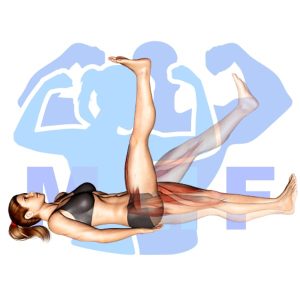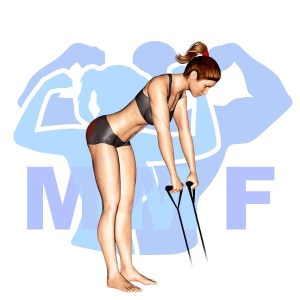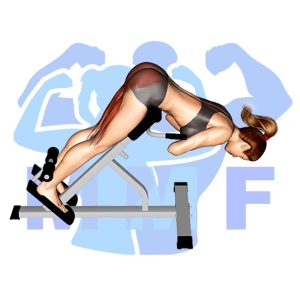Do you struggle with lower back pain or weak abs? Have you tried countless exercises to no avail? If so, you’re not alone. Many people experience frustration when their usual workouts fail to target these areas. But don’t worry, there’s a common culprit for this problem – a lack of focus on the reverse crunch. Neglecting this movement can lead to serious imbalances in the body, causing unnecessary discomfort during everyday activities. In this blog post, we’ll delve into the importance of the reverse crunch and provide step-by-step guidance on how to effectively perform this exercise to alleviate lower back pain and strengthen your abs.
Reverse Crunch Summary
- Primary Muscles: Rectus Abdominis
- Secondary Muscles: Obliques
- Equipment: Body Weight
- Mechanics Type: Isolated
- Force: Pull
- Utility: Auxiliary

Reverse Crunch Instructions
- Start off by laying on your back with your knees bent in a normal crunch position.
- Place your hands at your side for support.
- Next, roll your knees up to your chest for the reverse of a crunch.
- Lower your knees back down, do not let your feet touch the ground.
- Continue your Reverse Crunch for 10-20 reps.
Video Tutorial
Reverse Crunch Muscles
Target (Agonist)
Synergists
Dynamic Stabilizers
- None
Stabilizers
- None
Antagonist Stabilizers
- None

Benefits of Reverse Crunch
The Reverse Crunch is an effective exercise for strengthening and toning the Rectus Abdominis. This exercise targets the lower abdominal muscles, which helps to flatten the abdomen and create a tighter core. It also helps to increase stability of the spine and improve posture. Additionally, performing Reverse Crunches in a strength training or fitness routine can help to improve overall balance, coordination, and agility. This exercise is a great way to challenge the abdominal muscles and add variety to your workout routine.
Tips for Performing Reverse Crunch
If you’re seeking to take the reverse crunch to the next level, then you’re at the right place. Using these suggestions can enable you to maximize the advantages of this amazing exercise. You’ll have the ability to shape your abs muscles, and minimize your chance of getting hurt. So let’s get begin and see what these tips can do for you.
- Engage your core – keep your abs tight and engaged throughout the exercise to get the full benefit of the movement. This will help you build a strong and toned core.
- Maintain proper form – make sure you keep your chin tucked and don’t pull on your neck as you lift your legs. This will help you get the most out of the exercise and avoid any potential injury.
- Control the tempo – go slow and controlled throughout the movement to maximize muscle engagement and get a good burn. This will help you build strength and endurance while avoiding strain on your joints.
Benefits and Tips Video
Frequent Mistakes To Avoid
Staying away from mistakes can be the difference between a successful training session and an injury when executing reverse crunch. Additionally, getting the most out of the exercise requires proper form, and making sure you don’t make any typical mistakes can allow you to perform the exercise correctly and obtain your desired results. Don’t worry, though, it’s not at all difficult as it may appear. You can perform the exercise safely and effectively by avoiding the mistakes to avoid and by following the correct steps. Let’s begin by staying away from these typical mistakes and incorporating this exercise to your training regimen.
- Not engaging their core muscles during the exercise: Not engaging the core muscles during the Reverse Crunch can limit the effectiveness of the exercise and also make it less safe.
- Using too much momentum: Using too much momentum during the Reverse Crunch can result in unnecessary strain on the lower back, which can lead to injury.
- Not controlling the movement: If you don’t control the movement of your body during the Reverse Crunch, you won’t be able to target your abs as effectively and may not get the desired results.
Find More Bodyweight Exercises Here
Variations and Complementary Exercises
Reverse crunches are great for toning and strengthening the core, but there are a variety of other exercises you can do to get the same results. Below is a list of variations, complementary, or alternative exercises that work similar muscles as the Reverse Crunch.
Plank Hip Lift

The Plank Hip Lift is a great alternative or complementary exercise to the Reverse Crunch. It is a great way to target the abdominal muscles while engaging the hip flexors. To do this exercise, start in a plank position and then lift one leg as high as possible towards the chest. Make sure to keep the core tight and hold for three seconds before returning to the starting position. This exercise will help to strengthen the abdominals and hip flexors, making it a great addition to any ab workout.
Plank

Plank is a great complementary or alternative exercise to the Reverse Crunch. It targets the same core muscles, but with a different focus. Plank requires you to hold your body in a straight line for an extended period of time, engaging your abdominal muscles, lower back, and glutes. This isometric exercise helps to build strength and stability, which can improve your overall performance during the Reverse Crunch. Additionally, it helps to increase your range of motion, making it easier to perform the Reverse Crunch with proper form.
Lying Straight Leg Raise

The lying straight leg raise is an excellent complementary or alternative exercise to the reverse crunch. It targets the same abdominal muscles, but in a slightly different way. To perform this exercise, you lie flat on your back and lift your legs straight up in the air, keeping them as straight as possible. You can keep your arms by your sides or place them behind your head for added resistance. This exercise strengthens and tightens the lower abdominal muscles, while also helping to improve balance and stability.
Check Out These Top Bodyweight Exercises
Lying Alternating Leg Raises

Lying Alternating Leg Raises is a great alternative or complementary exercise to the Reverse Crunch. This exercise works both the lower and upper abdominal muscles as well as hip flexors. To do this exercise, lay flat on your back with your hands on the floor by your sides and your legs straight. Then, raise one leg straight up into the air as far as you can without arching your back. Return the leg to the starting position and then repeat with the opposite leg. This exercise can be done for time or repetitions and can help to strengthen and tone the abdominal muscles.
Lever Lying Crunch (Machine)

The Lever Lying Crunch machine is an excellent alternative or complementary exercise to the Reverse Crunch. This machine works the abdominal muscles in a slightly different way by allowing for a more natural range of motion. This machine also eliminates the need for extra balance, as the feet are secured in place. The Lever Lying Crunch allows users to target their lower abdominals while still engaging their upper abdominals, making it an effective and efficient core exercise. Additionally, this machine can be adjusted to fit various fitness levels, so it can be used by both beginners and advanced athletes alike.
Legs Up Crunch

Legs Up Crunch is a great complementary or alternative exercise to the Reverse Crunch. It targets the same core muscles, but from a different angle. Legs Up Crunch involves lying on your back and lifting both legs in the air. While keeping your lower back flat on the ground, you then crunch your upper body up towards your legs and repeat the motion for a set number of repetitions. This exercise is a great way to work on your core strength and stability, as well as providing an effective full body workout.
Find More Abs Exercises Here
Opposing Complementary Exercises
To maximize the effectiveness of the Reverse Crunch, try adding these exercises to your workout routine. These exercises are designed to target opposing muscle groups, which helps create balance and stability in your core.
Resistance Band Hip Extensions

Resistance Band Hip Extensions are an effective and complementary exercise to the Reverse Crunch. Hip Extensions work the opposite muscle group as Reverse Crunches, activating the gluteus maximus and hamstrings. This makes them an ideal pairing for those looking to build strength and stability in the lower body. Resistance Band Hip Extensions focus on extending the hips forward, while Reverse Crunches focus on contracting them back towards the spine. Working both movements together helps to ensure balanced development of the lower body muscles, as well as improved overall stability.
45 Degree Hyperextension

The 45 Degree Hyperextension is a great complementary exercise to the Reverse Crunch as it targets the opposing muscle group in the lower back and posterior chain. It focuses on strengthening the lower back muscles as well as the glutes and hamstrings while also increasing flexibility in the spine. The 45 Degree Hyperextension can be used to increase strength and stability in the lower back while also helping to improve posture. This exercise can also help to reduce lower back pain by improving spinal alignment and flexibility. By using both exercises, the Reverse Crunch and 45 Degree Hyperextension, in combination you can target both the anterior and posterior muscle groups to improve your overall core strength.
Straight Leg Cable Pull Through

The Straight Leg Cable Pull Through is an excellent complementary exercise to the Reverse Crunch. This exercise targets the posterior chain, primarily the hamstrings, glutes, and lower back muscles. It requires you to pull the cable from behind your legs, up through your hips and torso. This movement helps to strengthen and tone the posterior muscles, while the Reverse Crunch works the abdominal muscles. By alternating between these two exercises, you can create a balanced workout that targets both opposing muscle groups for maximum benefit.
Get Stronger Abs with Reverse Crunches
If you’re looking to strengthen your abs, reverse crunches are a great option. This exercise targets your lower abs and helps to create a stronger core. When performing reverse crunches, it’s important to focus on proper form and engage your abs throughout the entire movement. As you bring your legs up towards your chest, use your abs to lift your hips off the ground. Take it slow and steady, and try to avoid using momentum to complete the exercise. With consistent practice, reverse crunches can help you achieve the stronger abs you’ve been working towards.
References: Wikipedia | ExRx.net | PubMed.gov | Comprehensive List of Abs Bodyweight Exercises

